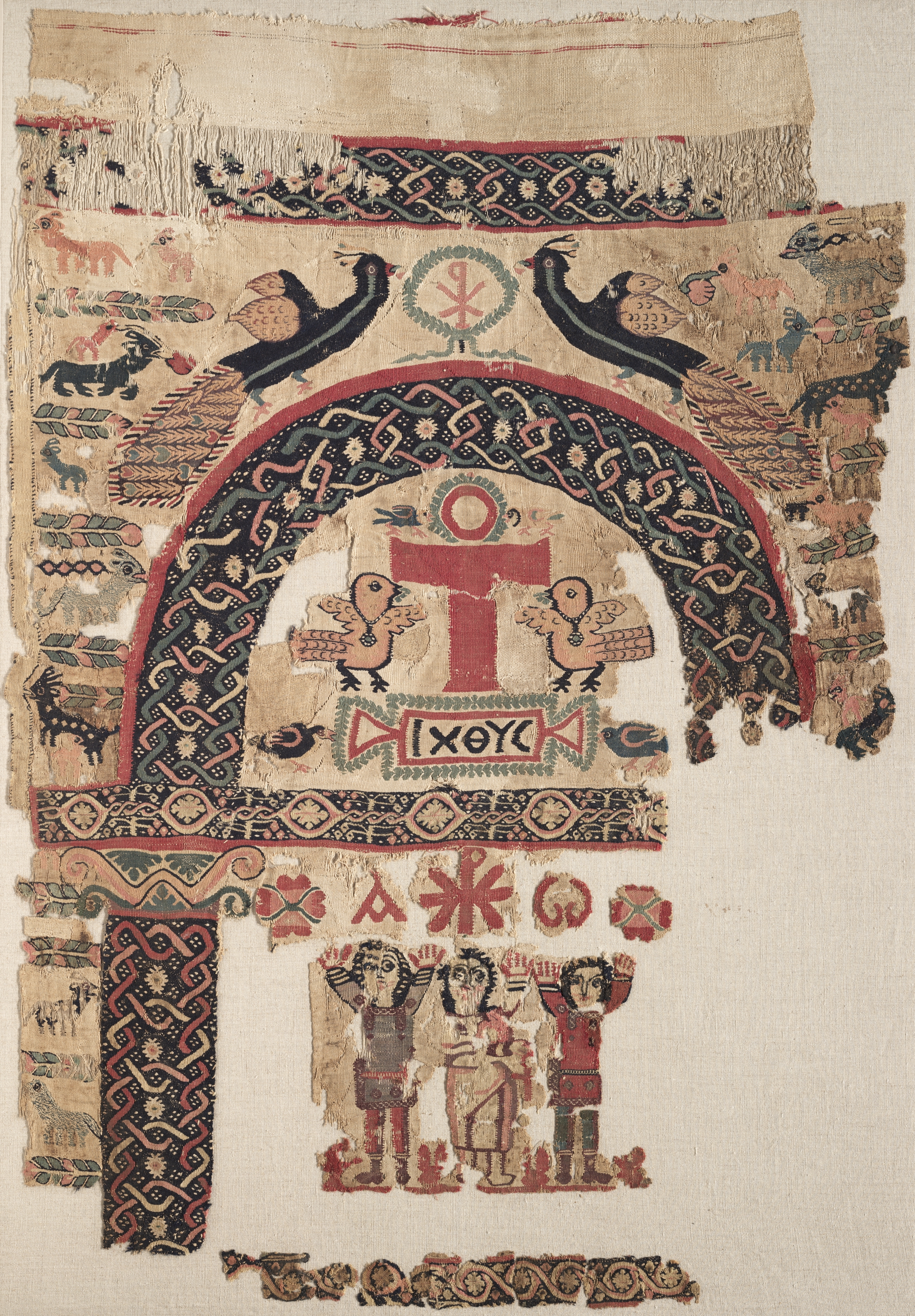The Cleveland Museum of Art
Collection Online as of April 27, 2024

Hanging with Christian Images
500s
Overall: 110.5 x 76.8 cm (43 1/2 x 30 1/4 in.); Mounted: 120.9 x 87 x 3.9 cm (47 5/8 x 34 1/4 x 1 9/16 in.)
John L. Severance Fund 1982.73
Location: not on view
Did You Know?
The two peacocks in the upper half of this composition represent immortality. Ancient Greeks and Romans believed that the body of the peacock did not decay after death and when this imagery was adopted by Christianity, the bird came to be associated with resurrection.Description
The significance of this rare hanging with Christian symbols outweighs its fragmentary condition. It likely served as a decorative wall hanging in a church or a home. Beneath the entablature of the arch decorated with interlacing bands stand three young men dressed in tunics, their arms raised. They may represent the three Hebrews who refused to worship a golden idol, and when cast into the fiery furnace, remained unharmed due to God’s deliverance (Daniel 3:19–30). Above them is a Christogram formed by the first two letters of Christ’s name in Greek, X (chi) and P (rho), flanked by the letters alpha and omega. Beneath the arch, an ankh, an ancient Egyptian symbol of life, is framed by two birds. Another Christogram appears above the arch between two peacocks. The significance of the combined use of these images and symbols lies in their invocation of Christ’s redemptive and life-giving power.- -1982(Jean-Loup Despras, Paris, France, sold to the Cleveland Museum of Art).1982-The Cleveland Museum of Art, Cleveland, OH
- Lee, Sherman E. “Year in Review for 1982.” The Bulletin of the Cleveland Museum of Art 70, no. 1 (1983) no. 75, p. 53, illus. p. 25 www.jstor.orgKlein, Holger A. Sacred Gifts and Worldly Treasures: Medieval Masterworks from the Cleveland Museum of Art. Cleveland, Ohio: Cleveland Museum of Art, 2007. Mentioned and reproduced: P. 68-69, no. 17Williams, Elizabeth Dospěl. "Sacred Imagery." In Woven Interiors: Furnishing Early Medieval Egypt, 63-68. Washington: The George Washington University Museum and The Textile Museum, 2019. Mentioned and reproduced: P. 65-66, fig. 13Sörries, Reiner. Der frühchristliche Kirchenraum: Ikonographie - Ausstattung - Liturgie. 2020. Mentioned: p. 128; reproduced: Tafel 54, Abb. 80bSánchez Galera, José María, and Gregorio Luri Medrano. La edad de las nueces: los niños en el Imperio Romano. Madrid : Ediciones Encuentro S.A., 2021. Reproduced: p. 316, fig. 41Achi, Andrea Myers, et al. Africa and Byzantium. New York : The Metropolitan Museum of Art, 2023. Mentioned and reproduced: pp. 200-201, fig. 75
- Coptic Textile Rotation Gallery 106. The Cleveland Museum of Art, Cleveland, OH (organizer) (May 15, 2018-May 13, 2019).Coptic Textile Rotation Gallery 106. The Cleveland Museum of Art, Cleveland, OH (organizer) (May 23, 2012-May 2, 2013).Sacred Gifts and Worldly Treasures: Medieval Masterworks from the Cleveland Museum of Art. National Museum of Bavaria, Munich, Germany (May 10-September 16, 2007); J. Paul Getty Museum, Los Angeles, CA (October 30, 2007-January 20, 2008).Byzantine Gallery 210 Rotation. The Cleveland Museum of Art, Cleveland, OH (organizer) (October 16, 2002-October 27, 2003).The Year in Review for 1982. The Cleveland Museum of Art, Cleveland, OH (organizer) (January 5-February 6, 1983).
- {{cite web|title=Hanging with Christian Images|url=false|author=|year=500s|access-date=27 April 2024|publisher=Cleveland Museum of Art}}
Source URL:
https://www.clevelandart.org/art/1982.73